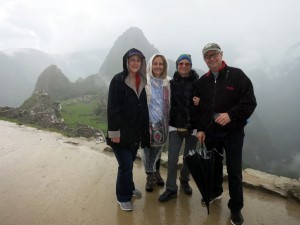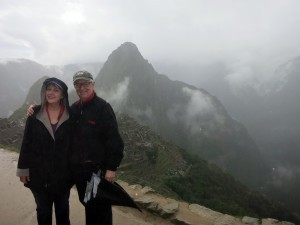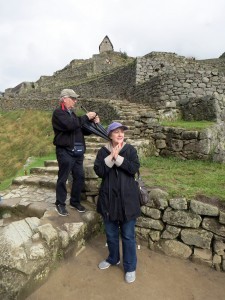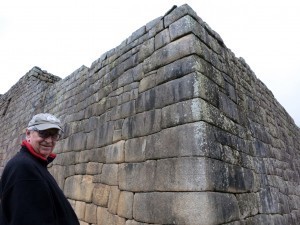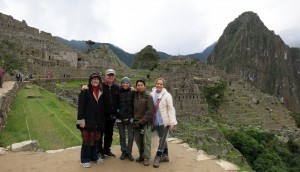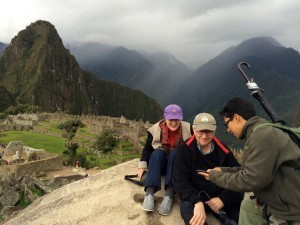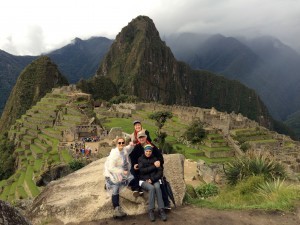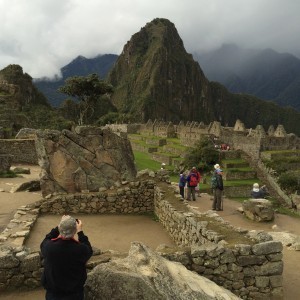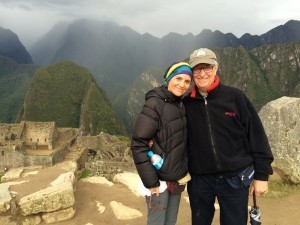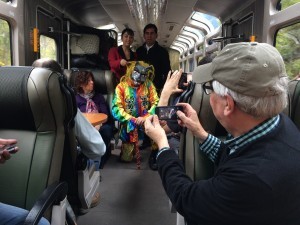Colin C. Tipping's Blog, page 2
April 22, 2015
Our trip to Machu Picchu, Cusco, and Sacred Valley
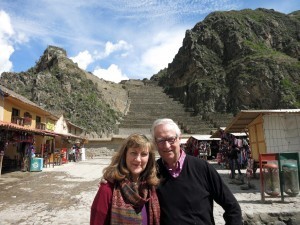 We got back to Atlanta early yesterday morning from Peru. Having completed the workshops we had embarked on a tour that took in Machu Picchu, Cusco, and Sacred Vally. It was amazing. Traveling with Muss and Ana, our two incredible Peruvian Radical Living Coaches, we had a blast.
We got back to Atlanta early yesterday morning from Peru. Having completed the workshops we had embarked on a tour that took in Machu Picchu, Cusco, and Sacred Vally. It was amazing. Traveling with Muss and Ana, our two incredible Peruvian Radical Living Coaches, we had a blast.
At 7,000 feet, atop a seemingly unscaleable mountain, the Inca city of Machu Picchu is nothing short of spectacular. How they did it is beyond imagination. Still today, no-one knows how they so accurately shaped and placed the huge stones that form the walls of the buildings and terraces. (See pictures.)
They had no tools that would even touch the hard granite, let alone carve them into shape with such precision. They had not yet discovered the wheel so had no pulleys to help lift the stones that each weighed many tons. It boggles the mind how they did it.
It reminded me of Stonehenge, of course, with it’s massive stones that still begs an explanation as to how they got there, too.
We were lucky in that most of the ‘tourists’ had left by the time we arrived, so it was not at all crowded. That’s very unusual since it has become not a place just for back-packers and spiritual seekers, but a must-see place for all, with a great train service to take you there. Hence large crowds.
We found a spot where we could meditate for a while. I have to say, for me, I did not connect with anything of a spiritual nature and was left wondering why the place was particularly meaningful as a sort of ‘mecca’ for spiritual people. What do they see and feel that I didn’t?
What I felt, as I tuned in, was the intense suffering of all those many thousands of slaves and minions who must have toiled endlessly and painfully to manifest this city in such an inhospitable and unforgiving environment and in so short a time. (The Incas only lasted for 150 years.) And for what, I had to ask?
Yes, Machu Picchu does qualify as the 9th wonder of the world in terms what was achieved, and I was certainly awe-struck by it. But I was not inspired by it. I was unable to make sense of it.
Maybe I missed the point but to my eyes today, it seemed like a huge waste of human energy and lives for no better reason than to please a king and to glorify some god. And that sounds all too familiar, don’t you think?
For all that, I am very glad to have seen it with my own eyes and experienced the incredible majesty of it. Cusco, which was the Inca capital, was also inspiring though, at 11,300 feet, breathing was a bit of a challenge.
Now it’s back to work.
April 15, 2015
What’s in a Name
“ What’s in a Name?”
A few months ago we put out a survey to see whether or not we should change the name of the Miracles workshop or not. The reason we felt it might be necessary was that when Sounds True took over the publication of the Radical Forgiveness book, they changed the subtitle.
It used to be “Making Room for the Miracle.” Our Miracles workshop connected with that subtitle, so it had meaning. But they changed it to, “A Revolutionary 5-Stage Process to Heal Relationships, Let Go of Anger and Blame and Find Peace in Any Situation.”
This is, in fact, much more descriptive of the actual process and indeed the workshop itself, but it doesn’t roll off the tongue as well. It’s not as memorable, either. But it does communicate what the person might expect to achieve either by reading the book or doing the workshop.
Anyway, we asked you all whether, having lost the connection with the original subtitle, we should change the name of the workshop. Well, we had lots of suggestions but nothing really decisive emerged.
There was a clear split between those who had done the workshop and, having experienced a whole series of miracles in their lives since doing the workshop, very much wanted to keep the name the same, and those who felt it needed to change so people would instantly get what it was about.
Quite honestly, we are still in debate about it ourselves. We are, in fact, in the middle of a complicated process right now looking at what we need to update about our brand and positioning, so this question is one among many that we will be looking at. For now though, it stays as “The Miracles Workshop.”
Those of you that have your own business, will know that names count and that you have to keep adjusting things to make sure you are still communicating with the people you wish to be in touch with, in the right way. You will also realize that titles, banners, logos, and pictures matter a great deal.
So, that’s the process we are in at this time. Don’t be surprised, therefore, if you see some changes in our website in the near future, for example. Or, that I might be offering some new services and products. It is an exciting process.
Another thing that has changed over the last few years is how the word Radical has become much more ubiquitous, to the extent that it has started to become meaningless. Not that I am going to give up using it for Radical Forgiveness, since that is my brand and it remains strong, but I do have to be watchful that it does not simply get lumped in with all the other subjects to which the word radical is now being attached for no other reason that the word has become rather fashionable.
It’s interesting how we take a word that means something extraordinary and then use it repeatedly to describe what is ordinary and commonplace. Take the word awesome, for example. It used to mean that we would be awe-struck by something if we came across it. Now, today, even an ice cream is awesome.
The word Radical is heading in that direction now as well, so I want to make sure that Radical Forgiveness continues to be seen as extraordinary and radically different to anything else out there, with the possible exception of A Course in Miracles with which it has some similarity. That, too, is about forgiveness but not the kind we’ve all been conditioned to believe is little more than letting bygones be bygones.
It’s worth looking at the dictionary definition of the word radical. It gives two. First, it adds gravitas to the subject to which it refers in that it implies having got to the very root or essential core of that subject. Second, it also makes the subject, if not exactly revolutionary, certainly is cutting edge and very much out of the ordinary.
Unfortunately, it has also become associated with extremist politics and even terrorism. This has caused some foreign publishers to avoid the word altogether. Nevertheless, I think I can still get away with using it to qualify a word like forgiveness, at least in the U.S. and UK. But I still need to keep my eye on it.
Brad Blanton wrote a book in the early 90s called Radical Honesty, and I am not ashamed to say I followed his lead and called my first book, Radical Forgiveness. But at that time the word radical still carried its true meaning and, with my book anyway, led people to ask themselves, in what sense is this form of forgiveness cutting edge or phenomenon in a way that is radically different to ordinary forgiveness. It was more than just a cute label. Same with Brad Blanton. His approach to being honest was truly radical too.
But that has changed. If you look in Amazon, you will even see now, two or three books with the title, Radical Forgiveness as well as other books with Radical in the title. That word is now over-used and degraded. Without the word Radical to qualify forgiveness, people will default back to how it was seen when the word radical was not attached to it. These changes could easily blunt my message and my brand.
That’s why it is important that I keep finding ways to explain just how different Radical Forgiveness is from traditional forgiveness and the extent to which when we embrace the worldview on which it rests, we are changed by it. I mean, fundamentally changed. Jolted out of our slumber, if you will. Awakened to a wholly new reality. When we embrace the underlying assumptions of Radical Forgiveness, we see everything through different eyes.
Neither is it just about healing some terrible trauma or grievance that occurred in the past and is therefore only applicable to a few people who need it. Radical Forgiveness can do that really well, of course, and do it very quickly, but it is so much more than this.
It is a way for anyone and everyone to deal with everyday problems and challenges as they occur so as to move through them with ease and grace. It is a way of living consciously and with awareness of how everything is connected and meaningful, so we don’t become trapped in fear and wallow forever in victim consciousness.
It’s about finding peace and happiness in our lives and being responsible for what happens instead of blaming everyone else or beating ourselves up for making mistakes or not being good enough.
April 8, 2015
Art for the Health of It
On the webinar last Thursday we discussed how art can be used in a very effective way to anchor the transformational shift brought about by the Radical Forgiveness experience.
As you may know, there are five stages in the Radical Forgiveness process: telling the story, feeling the feelings, collapsing the story, reframing the story and integrating the new story.
This last one often gets short shrift in discussions since the fourth one, reframing the story is the really radical one and gets all the attention. But the fifth one is very important. Without we find a way to integrate that reframe deep into our mind and body, it can dissipate. If this happens, we simply go back to our victim story.
To achieve this integration, we often use Satori Breathwork or walking the circle as when we do the Radical Forgiveness Ceremony. Even doing a worksheet and speaking it out loud is effective. Music is also good. But doing artwork in some form is a really excellent way to integrate the shift.
It is particularly useful If you are not a verbally inclined person and are not comfortable writing things down. Drawing or painting may suit you better. But even if you are comfortable writing it may well be very helpful to do some artwork immediately after doing a worksheet or listening to the 13 Steps. You may be surprised what will happen when you communicate to yourself in this manner.
Try if for yourself. Buy some decently sized white and black paper as well as some colored pastel chalks and crayons. (The pastels work really well on the black paper.)
Know that to use this tool requires no artistic talent whatsoever. It is not about painting pretty pictures. In fact, if you are full of anger, your pictures will probably be anything but pretty. It is about getting emotions and thoughts out on paper.
Begin drawing with no expectations or preconceived ideas. You might ask your spirit guides to help you release through the process of drawing and coloring whatever needs releasing and then simply start.
Whatever wants to come, allow it. Do not judge. Just go with the flow. Do this like a meditation. If you want to tell a story, do that. If you just want to use color, do that. Do whatever you feel like doing.
To use art therapy as a forgiveness tool, use an approach similar to that of the letter trilogy. Do a series of drawings that express how you felt about what a particular person did to you; these pictures would express your anger, fear, pain, sadness, etc.
Then, move into a more compassionate and understanding frame of mind, and do some drawings that reflect this attitude. Do a third set that expresses the feeling of Radical Forgiveness. You might want to put some time between each phase, or you can do them all in the same sitting.
Make sure, however, that once you start doing this art therapy, you complete all three stages — even if you only do three drawings in all. Doing just the first one, for example, might leave you stuck in anger.
As you finish each picture, hang it on a wall. Place each picture in the precise order in which you complete them and create a vertical or horizontal band on the wall with them. If you are creating a vertical display, begin with the first of the angry ones at the bottom and end with the last Radical Forgiveness one at the top.
When you place them in such a manner, you will be amazed to see the progression and the change in the quality of the energy expressed by each picture.
Title each drawing and date it. Spend some time with the drawings. Let them “speak” to you. While you were drawing each picture, you were thinking certain thoughts. When you look at the drawing later, clear your mind of those thoughts and examine the pictures for anything else of importance.
Though you would NEVER show them to those you are forgiving, you might invite others you trust to give you their interpretations of the pictures. They may see things you do not. Ask for their input by saying, “If this were your picture, what would you see?”
If what they see resonates with you, fine. If it does not really ring true for you, that is fine too. They see your drawing through their own subconscious, not yours, but you will find that people’s observations will trigger within you a whole new way of looking at your drawings, and you may have some new insights as a result.
And who knows, the side effect might be that you have so much fun that you will want to do it again and again, just for its own sake.
Colin
P.S. On the webinar last Thursday we mentioned that Senior Coach, Shari Claire, Artist/Photographer Katie Klein and I were doing a workshop, April 24-26, that included artwork. Since this happened to clash with another large event in Atlanta the same weekend being promoted by the same church and attracting large numbers, we felt obliged to postpone our workshop until a later date. We apologize for any inconvenience this has caused.
March 25, 2015
The 3 Forms of Intelligence
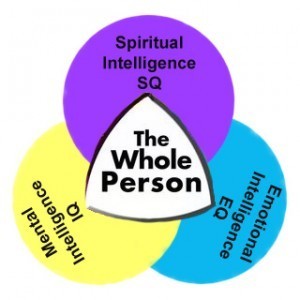 The 3 Forms of Intelligence IQ; EQ; SQ
The 3 Forms of Intelligence IQ; EQ; SQ
Which one of these three do you think is most important? Mental Intelligence; Emotional Intelligence, or Spiritual Intelligence? I’ll give you the answer at the end of this blog:
I bet you know your IQ, don’t you? If not you ought to. That is unless you’re like me and really don’t want to know in case it is a lot lower than you would like to think.
In England, when I was just a boy we all sat what was known as the 11+ exam. This was done to sort out which pupils would go on to the grammar schools to get a classical education or go to the less prestigious ‘secondary modern’ school where one was prepared for the job market. Since I failed my 11+, I made up my mind then and there that I would forever avoid taking intelligence tests and have, so far, succeeded in doing so. I still don’t know.
IQ is a measure of one’s mental intelligence. It covers all cognitive activity of the rational mind – thoughts, ideas, concepts, paradigms, and theories. It has enabled us to go to the moon and back, develop amazing medical procedures to cure disease and to develop sophisticated models of the world through science and mathematics, among a million other wonderful achievements that have benefited mankind. I used it to write my book about Radical Forgiveness and develop my theory around it, but it doesn’t do Radical Forgiveness. For that, we need our Spiritual Intelligence.
Even if you do know your IQ, I bet you have no idea what your EQ is, do you? EQ is your emotional intelligence. Is there even a way to measure it? Emotional intelligence is the intelligence of the heart.
Our Emotional Intelligence guides our emotional responses to life, whether fear-driven, love-driven, guilt driven, pleasure driven, etc. It tells us when we are in denial, lying and out of integrity. It enables us to relate to each other at the heart level with compassion, empathy, tolerance, humility, forgiveness, etc. Without emotional intelligence, we would either be like robots – machines that can think but can’t feel, or sociopaths unable to control our emotions. Because people are taught to value Mental Intelligence more and to deny their feelings, Emotional Intelligence is quite underdeveloped in humans.
In spite of this, our lives are driven far more by unconscious emotional responses than by rational thought. We allow our emotions to override our thoughts. That leads to the formation of mental structures like bigotry, prejudice, unreasonable attitudes, inflexibility of mind, false beliefs, denial, and so on. We often believe what we want to believe; not what makes sense.
Our Spiritual Intelligence is the intelligence of the Soul. It is the most subtle of the three and operates below our level of awareness. It knows the truth of who we are, and it connects us to the world of Spirit and Universal Intelligence (God). Our body is the antennae for our Spiritual Intelligence. Our Spiritual Intelligence guides us on our spiritual journey, always moving us in the direction of growth and healing. It is our internal spiritual compass. It keeps us on track with our Divine Plan.
It finds its outer expression in our everyday lives as spiritual practice, the search for meaning beyond this reality, contemplation and meditation, prayer, etc. It is not bound by time and space. It comes into play when we ask for help and open up to receiving help from the spiritual realm. Religious dogma hardly qualifies since that is mostly mental.
The tools and processes of Radical Forgiveness provide a perfect way to ask, even if we are skeptical about the whole idea. Without Spiritual Intelligence, Radical Forgiveness would not be achieved for it is that faculty we call upon the most when we do the Radical Forgiveness work.
The tools depend utterly on our connecting with our Spiritual Intelligence. That’s why we need to use the tools. If we don’t use them, we default to trying to do it in our heads using Mental Intelligence instead, and that doesn’t work. Mental Intelligence is useless for spiritual work. It is not designed for that.
Now let me address the question I asked at the beginning. Which of the three is most important? The answer is none of them. Just as we say that mind, body, and spirit are integrated as a whole, and no one is more special than the other, the truth is that all three forms of intelligence are equally important and need to be given equal standing.
The problem arises when we imagine that one is more important than the other. Unfortunately, for at least the last 300 years or so, Mental Intelligence has been elevated so far above the other two, in fact almost to the exclusion of them, that we have become terribly out of balance. This probably accounts for many of our current world problems. Descartes relegated the soul to being the pineal gland and scoffed at the idea that the heart has its own brain, which science now proves it has.
On the other hand, if we allow our emotions to constantly over-ride our thoughts, this leads to the formation of mental structures like bigotry, prejudice, unreasonable attitudes, inflexibility of mind, false beliefs, denial, and so on. Then we start to believe what we want to believe, not what makes sense.
Then again, if we allow ourselves to become overly spiritual to the point where we are out of body most of the time and forever needing to consult our guides, psychics, astrologers, etc., constantly meditating as a way to avoid being in the world, we will be just as out of balance. We are spiritual beings having a human experience. To live it fully, we must let it be an in-body experience, not an out-of-body experience. If we deny the body, we shut off our access to our feelings. That makes no sense when you consider that we came here to experience life as an emotional experience. That is precisely why we have a body. So be in the world though not of it.
March 18, 2015
Who the **Bleep!?** Am I?
 Who the **Bleep!?** Am I?
Who the **Bleep!?** Am I?
Last weekend, during the Radical Self-Forgiveness/Self-Acceptance Workshop, 20 courageous souls got answers to that question. They also found out what was getting in the way of knowing the truth of who they were.
This is what this workshop was all about. Coming to understand why and for what purpose we have created harsh and painful divisions within ourselves and then, once we’ve awakened, how to heal them once and for all.
Being able to see the real spiritual purpose behind what happened, for which guilt and even shame might be appropriate at the human level, was both enlightening and liberating for them. The spiritual reframe came easily once responsibility was accepted and owned.
They arrived having already done, in preparation for the workshop, our new free online program called Who the **Bleep!?** Am I? * This proved to be great prep work for a number of exercises in the workshop.
Quite a few of them carried with them the curse of perfectionism. For them to embody the idea that our perfection lies in our imperfection was huge for them. (We have to be imperfect in order to provide opportunities for others to see and then reframe their own imperfections in the mirror we provide.)
They also learned that most of the shame-based beliefs they had about themselves were the result of having been shamed or mistreated by others to the extent that they had come to embody the idea that they were irredeemably bad.
Since this was the case for almost everyone in this group, we decided to do a Radical Forgiveness Ceremony instead of the Projection Game. (The Ceremony enables us to forgive ourselves and everyone else in our lives in the space of just 2 hours.)
However, there were several in the group who felt they still needed to heal one or more specific forgiveness issues in order to be free of the negative effects they were having on their lives. They decided there and then to sign up for the Miracles Workshop in May in order to take care of those issues. That’s how committed they had become to their own healing.
(Note: Since the Miracles Workshop is limited to just 12 people, this means there are only 5 spaces left, so if you are thinking about doing it, you might need to jump in quickly.)
Fortunately, I was relieved of having to stress the need to do the worksheets. Dean, one of the participants let it be known in no uncertain manner how he had done hundreds of worksheets in the last couple of years, how he used them to control his anger with his employees, often doing 3 or 4 each day, and how it had changed his life and improved his business. He sold it to the group better than I ever could. I was very grateful for that.
As well as paper worksheets, each participant was given a thumb drive on which was loaded the recording of the webinar I did the week before on the combination RF/RA Worksheet. The recording of the 13 Steps to Radical Self-Forgiveness was also on it, so they had all the tools necessary to maintain the peace and high self-worth gained over the weekend.
It was a great group, and everyone bonded deeply. The level of love and support given and received was wonderful. It was a great experience for me as well as for them. I look forward to doing it again.
* This brand new online program is designed to help you discover who you are, how you show up in the world, what strategies you use to get what you want, how you handle certain life situations and so on. It is available for all to use as a vehicle for gaining self-knowledge, much of which we ordinarily keep hidden from ourselves. Try it for yourself. (It is available in the Free Stuff section of Colin’s Cafe. (If you aren’t already a member, registration is required.)
Remember, knowledge is power, but self-knowledge is wisdom.
March 11, 2015
Worksheets Rock!
 Did you miss the webinar last Thursday? And the replay? Pity. You would have enjoyed it. Along with all the others, it is now in the archives of Colin’s Cafe, our membership site.
Did you miss the webinar last Thursday? And the replay? Pity. You would have enjoyed it. Along with all the others, it is now in the archives of Colin’s Cafe, our membership site.
The webinar was on how to tap into the full power of the combined Radical Self-Forgiveness/Self-Acceptance Worksheet.
The response was phenomenal. We could have gone on all night with the Q&A session.
Of the 1,133 initial registrants for the webinar, 258 were on the call live and another 278 listened to the replay. This is much better than average take-up, so the interest in the topic was high.
We also noticed there was a lot of people on the call who were not already on our list. If you were one of them, I would like to welcome you personally. I trust you found it inspiring and helpful.
With this webinar, we have now covered all four of the worksheets associated with the four strategies for Radical Living:
Radical Forgiveness,
Radical Self-Empowerment (includes Self-Forgiveness and Self-Acceptance),
Radical Transformation, and
Radical Manifestation.
These worksheets really do rock. Our success in finding peace in any situation within minutes of doing them, or manifesting what we want in our lives, depends on them. If we try to do the work in our heads, our intellect gets in the way. These worksheets bypass the mind and use our Spiritual Intelligence instead.
As we go through the process of doing a worksheet, we invoke energies of a very subtle nature. The speed with which change comes about through their use proves that subtle energy is infinitely more powerful than egoic force, struggle and effort. I call the process of doing the worksheet secular prayer.
Having proven this Tipping Method worksheet technology to be so effective, we are very keen to share it with as many people as possible, so we make them all available for free from our website. Sign up at http://www.radicalforgiveness.com/free-stuff/.
For a very small, one-time price, we also have a whole set of online interactive worksheet programs for those who like to do them online and want to have them available for lifetime use.
These worksheets also form the basis for our first level of professional training. Our Radical Living Coaches are trained to instruct people how to use the worksheets associated with the four Radical Living Strategies, and how to apply the strategies to all manner of problems and challenges of everyday life.
We hope you get as much out of them as we do in making them available.
Blessings,
Colin
March 5, 2015
Today’s the Day
You probably haven’t forgotten that today is the day we are doing the Self-Forgiveness/Self-Acceptance Webinar, but I thought I would send you a quick reminder anyway, just in case.
I know how easy it is to let it slip by you even on the day, and I don’t want you to have this be another excuse to be mad at yourself.
I’ve done this myself a number of times, so I have taken to setting the alarm on my iPhone to alert me 5 minutes before the webinar is supposed to start. Set yours for 7:55 p.m. EST
To enter the webinar, click on this link.
Talk Later
Colin
February 25, 2015
Healing Infidelity
Healing Infidelity
 St. Valentine and Hallmark Cards have a lot to answer for. So have the authors of children’s books who finish their stories with the line . . .” and they got married and lived happily ever after.”
St. Valentine and Hallmark Cards have a lot to answer for. So have the authors of children’s books who finish their stories with the line . . .” and they got married and lived happily ever after.”
I was a speaker on a Valentine’s Day Cruise last week. What I observed did not support that idea.
What I saw was a lot of . . .” and then they got married, and became disappointed and disillusioned not too long after.”
Of the 31 people in my seminar, 25 of them had experienced marital breakups. Of those, 11 of them cited infidelity by their partner as the cause.
Most of those who experienced that event in their lives were more than deeply wounded by it.
Naturally, our sympathy nearly always goes to the aggrieved party, because we can easily identify with their pain. We can readily imagine how we would feel if our partner betrayed us in that way.
On the other hand, we have precious little sympathy left for the one who strayed and did the cheating, especially if it repeatedly happened.
However, my contention is that there’s very little difference between being a victim or a perpetrator, in energetic terms. Each is the opposite side of the same coin. The big difference is how much support we get.
Of the 31 people in the room, (14 couples, 17 singles), 8 openly admitted to having had affairs. Of those, there wasn’t one who didn’t feel a lot of guilt and shame about having lied, hurt their partner, and destroyed the trust on which their relationship was built. Their pain was equal to those they betrayed.
They were hurting, too, even if they were trying to hide it. They needed help no less than those who saw themselves as the victims.
We see this all the time in our Radical Self-Forgiveness workshops. A very high proportion of people, both men and women, who come to this workshop, come to work through their guilt and shame for having cheated on their partners and having experienced their own version of hell as a consequence.
They recognize how much pain and chaos they have inflicted, not only on their own family, but on the person they had an affair with, and even on that person’s family. The damage done may have cost them their marriage, their children, their reputation, and so on.
Look what happened to Senator John Edwards after having been outed as a cheater on his wife, Elizabeth, while she was supporting his bid for the White House even while she was battling cancer.
Like we all do when we feel ashamed of what we have done, and whom we think we have become as a result of our actions, he did his best to hide it. Just as he did, we try to justify our own crimes, make excuses, and shift the blame onto others.
But, as much as we try to get ourselves off the hook, there’s no escaping the guilt and shame, not to mention the punishment.
I would have loved to have had him in my Radical Self-Forgiveness workshop and his wife, Elizabeth in my Miracles (Radical Forgiveness) workshop.
I might not have been able to save his career, nor could I have healed her cancer, but I most certainly could have saved both of them a great deal of pain.
Who knows what a difference it might have made to the outcome for them and everyone else involved?
The work Dinny Evans is now doing with prisoners doing life for murder in San Quentin State Prison also proves that it’s only when we bring forgiveness to bear on both the victim and the perpetrator that real healing can begin for either.
Conversely, it’s only when the victim realizes he or she was, at some level, responsible for creating the situation for his or her own spiritual growth, and the perpetrator is able to forgive himself or herself on the same grounds, that real peace can occur for both.
[For more information on how you can be involved in the prison project, click here.]
February 11, 2015
Depression Part 2
Depression Part 2
 Last week we looked at the idea that depression was some kind of a wake-up call from within, the message being, “Heal your pain or continue suffering.”
Last week we looked at the idea that depression was some kind of a wake-up call from within, the message being, “Heal your pain or continue suffering.”
I also claimed we have had a lot of success dealing with it through the Radical Forgiveness and Self-Forgiveness technology.
In this follow-up session, I would like to say more about the method we use that gets these results.
The first stage in Radical Forgiveness, as with all other methods, is to find a way to have you talk about what happened, without being judged, and without the listener trying to fix you. It is essential that you feel understood and that your feelings are validated.
The more you talk, the more the tension is released from your mind and body. Being encouraged to focus on body sensations as you talk gets you more in touch with the memories and feelings you experienced at the time, as well as those you experience as you relate your story.
Feeling the feelings is the second stage in the Radical Forgiveness process, and we know this to be a crucial step. You can’t heal what you don’t feel. I know you’ve heard me say that many times, but its true.
However, one of the effects of having used and made permanent one or more of the defense mechanisms, is that you may have numbed out. You’re unable to feel your feelings. It’s not that the feelings are not there. You are simply unable to access them.
Doing something physical helps you discharge pent-up “fight-or-flight” emotional energy—something explosive and fast-moving like beating some cushions with a tennis racquet. (It makes such a good noise!)
When you do this, the body takes over. Your mind gets out of the way and the resistance to feeling the feelings dissolves.
The anger erupts. You’re likely to collapse in tears, shake violently for a few minutes and then go quiet.
Then come the feelings beneath the anger – sadness, grief, hurt and very often, with soldiers having PTSD, survivor’s remorse.
“Why was I spared when my mates were killed? It should have been me.”
Beating the cushion is a technique I use all the time in Radical Forgiveness Therapy. You have to get in touch with the raw emotion behind what happened.
However, I never recommend that you do it on your own without having support from someone who can hold the space for you to go through the anger and the whole process without needing to intervene or being fazed by the process.
It is not always pretty and can be upsetting to someone who is not used to it.
As you probably know, the 3rd stage in the Radical Forgiveness Process is collapsing the story.
This is where we take some of the heat out of the trauma by trying to rationalize it, understand why it happened, what factors might have made it inevitable, and so on.
This is cognitive therapy, pure and simple, and for most people who have been traumatized, this is the end of the road. There’s nowhere else to go.
That said, it works well enough for man,y even though it takes a great deal of time and money, and in my view, probably leaves a lot undone.
With Radical Forgiveness, we take it to the next level. It’s at this stage that the healing really takes place and at a very fast rate.
The person is gently introduced to the idea that what happened was supposed to happen that way and that, far from being a tragedy, it was what their Higher Self had set up for them to experience. That’s when the healing process really takes off and goes into overdrive.
However, the timing has to be right. The Radical Forgiveness reframe has to be introduced carefully and with due respect for the person’s existing consciousness at the time.
If it is proposed too early, the person can be re-traumatized. The idea that they created it and that, from a spiritual perspective, it was entirely perfect might be just too radical for them.
My approach, when I have done all the emotional work and have completed the cognitive analysis, and feel the person is ready, goes something like this: “Would you possibly be open to seeing this situation from a different perspective?”
If I sense curiosity coming back from them, I then launch into it, step-by-step, looking to see how it might be landing for them.
I never ask them to believe it. In fact, I usually say, “I don’t believe it myself, but something happens if we just become willing to believe it. So, for a moment let’s just suppose…” And I go from there.
They nearly always buy it. Tentatively at first, of course, but gradually they find a sense of rightness about it. It resonates. They notice that they feel different inside. A weight has lifted from them. They become alive again.
My main experience over the years has been with people traumatized by sexual abuse and other relationship-based traumas.
But no matter how a person has been wounded or traumatized, I am totally convinced that Radical Forgiveness Therapy is at least part of the answer.
February 4, 2015
Healing Depression and PTSD, Part 1.
Healing Depression and PTSD, Part 1
 The constantly recurring question in the minds of those who are even just a little bit depressed, has got to be, “Why Do I feel like this?” And then, immediately following that, “What’s wrong with me?”
The constantly recurring question in the minds of those who are even just a little bit depressed, has got to be, “Why Do I feel like this?” And then, immediately following that, “What’s wrong with me?”
Now I’m not a doctor so I am not going to say that severe clinical depression is not a matter of brain chemistry getting out of whack.
I can also see that medication can be very helpful to people who are suffering this debilitating condition. No doubt about it.
But is the glitch in brain chemistry the cause or the effect? Surely there has to be a reason why our brain is producing chemicals that make us feel like we are not worth anything, we’re a total failure and that life is not worth living?
It’s not like there is a depression germ that you catch. It arises from within. But from where? What causes it? And, what is the remedy?
It seems clear to me from my experience with people who come to my workshops suffering from depression, that it has its origins in childhood wounds and traumas suffered in any stage of life.
I believe, too, that depression is our mind giving us a very strong message to radically heal the repressed and suppressed memories of those events and to deal with the emotions linked to them. And that, if we heed that message using Radical Forgiveness therapy, the depression goes away.
The high rate of suicide among soldiers returning from the wars in Iraq and Afghanistan is an indication of how overwhelming trauma can be.
Who wouldn’t be traumatized, being shot at all the time and threatened by bombs and roadside IEDs that might take off your legs and arms?
The unrelenting emotional pain and the feeling of helplessness, self-recrimination, anger and guilt that goes along with it, even after arriving back home, is so great that for some at least, suicide must seem to be the only way to find peace.
That they should see this as the only way out makes me very sad, because I know beyond a shadow of a doubt that Radical Forgiveness Therapy will enable them to heal and get on with life.
This is why I am offering any veteran of the Iraq or Afghanistan wars who is suffering in this way, to attend my upcoming Radical Self-Forgiveness/Self-Acceptance Workshop, March 13-15, at half price. (To register, call 1-972-202-9926.)
Of course, there are many ways, other than war, in which we can become traumatized, especially when we are children.
Trauma is caused by events that destroy our sense of security, and/or our trust in everyone around us and even threaten our lives. It can be caused by a one-time event like a natural disaster or a violent attack. Sexual abuse is almost always traumatic.
Trauma can also come from being in an ongoing, highly stressful situation, such as living with an abusive, dysfunctional family, living in a crime-ridden area or fighting a cancer diagnosis.
The sudden death of a loved one can be very traumatic, too, and can throw a person into depression especially if the grief is suppressed.
We all use natural defense mechanisms like denial, suppression or repression of the emotional pain to help us cope with the shock and the fear experienced in traumatic situations.
But if they become permanent, we store up trouble for ourselves. The price we pay for not dealing with the pain is inevitably things like depression, post-traumatic stress syndrome, addiction and other behavioural problems.
At the Institute for Radical Forgiveness Therapy and Coaching, we have found over the years that depression yields to the Radical Forgiveness and Radical Self-Forgiveness/Self-Acceptance process very quickly
Bringing the memories and the feelings of guilt, anger, resentment and fear attached to the trauma to the surface and transforming it in the way we do at the workshops does the trick most of the time. Even if you need to take medication to keep you functional, Radical Forgiveness should be at least part of your protocol.
In next week’s blog, I will explain in more detail exactly how we work with people with depression and PTSD. Stay tuned.
Colin C. Tipping's Blog
- Colin C. Tipping's profile
- 43 followers


